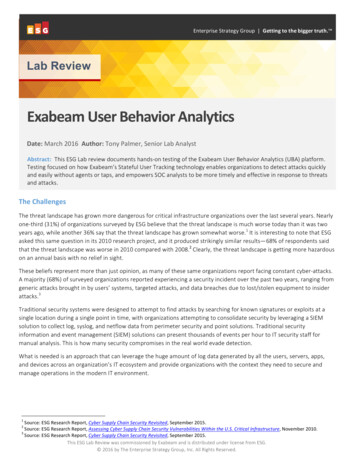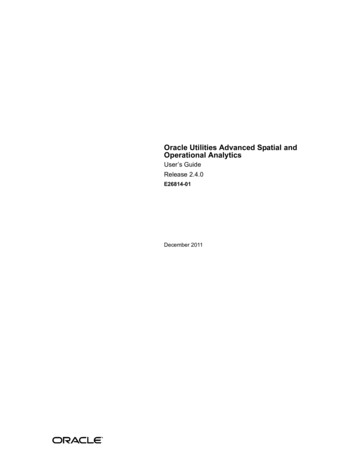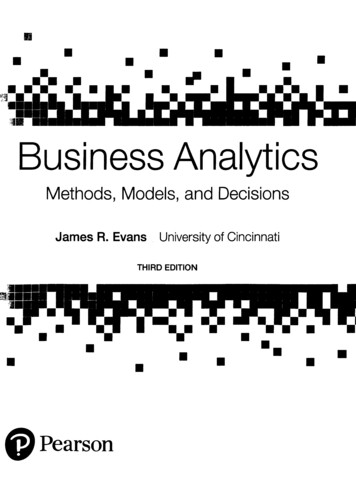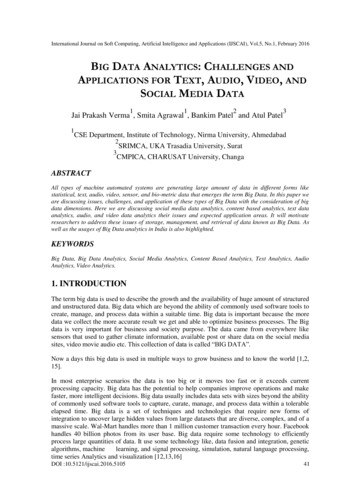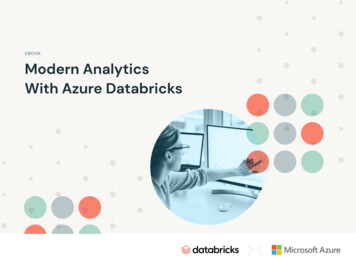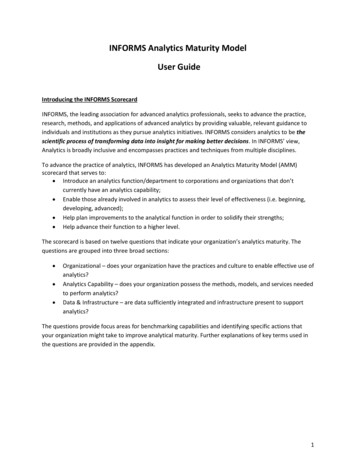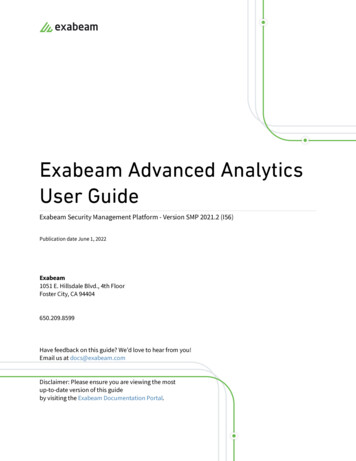
Transcription
Exabeam Advanced AnalyticsUser GuideExabeam Security Management Platform - Version SMP 2021.2 (I56)Publication date June 1, 2022Exabeam1051 E. Hillsdale Blvd., 4th FloorFoster City, CA 94404650.209.8599Have feedback on this guide? We'd love to hear from you!Email us at docs@exabeam.comDisclaimer: Please ensure you are viewing the mostup-to-date version of this guideby visiting the Exabeam Documentation Portal.
CopyrightAll content in this document, including text, graphics, logos, icons, images, and video clips, is theexclusive property of Exabeam or its content suppliers and is protected by U.S. and internationalcopyright laws. The compilation (meaning the collection, arrangement, and assembly) of all contentin this document is the exclusive property of Exabeam and is also protected by U.S. and internationalcopyright laws. The content in this document may be used as a resource. Any other use, including thereproduction, modification, distribution, transmission, republication, display, or performance, of thecontent in this document is strictly prohibited.Copyright 2022 Exabeam, Inc. All Rights Reserved.TrademarksExabeam, the Exabeam logo, Threat Hunter, Smarter SIEM, Smart Timelines and Security ManagementPlatform are service marks, trademarks or registered marks of Exabeam, Inc. in the United Statesand other countries. All other brand names, product names, or trademarks belong to their respectiveowners. The marks and logos displayed in this document may not be used without the prior writtenconsent of Exabeam or their respective owners.PatentsExabeam owns, and reserves all rights for, patents for Exabeam products and services, which may beprotected under registered patents as well as patents pending.Other PoliciesFor information regarding Exabeam’s treatment of personally identifiable information, please reviewExabeam’s current privacy policy at www.exabeam.com/privacy.
Table of Contents1. What Is Exabeam? . 51.1. Exabeam’s Role . 51.1.1. Get To Know Exabeam Terminology . 51.1.2. Get To Know Exabeam Use Cases . 61.2. How Exabeam Works . 71.3. Build A Baseline For Each User And Asset Using Training . 81.4. Confidence In Assessing Events . 91.5. Access The Exabeam User Interface . 91.5.1. Role-Based Access Control . 101.5.2. Mask Data In The Advanced Analytics UI . 102. Welcome To The Advanced Analytics Homepage . 122.1. High-Level Counters On The Advanced Analytics Homepage . 132.2. About The Notable Users List . 142.3. Watchlists . 142.3.1. Asset Watchlists . 152.3.2. Out-Of-The-Box Watchlists . 152.3.3. Customizable Watchlists . 152.3.4. Configure Role-Based Access Control For Watchlists . 162.4. Account Lockouts List On The Advanced Analytics Homepage . 162.5. Navigate To Other Pages, Sign Out, Or Change Password From The AdvancedAnalytics Homepage . 172.5.1. Bookmark Sessions . 172.6. Use Dark Mode In Advanced Analytics , Case Manager, And Incident Responder . 172.7. Change Language In Advanced Analytics, Case Manager, And Incident Responder . 183. Get To Know A User Profile . 193.1. 1 General Information . 203.2. 2 Data Insights . 203.3. 3 Active Incident(S) . 213.4. 4 User Risk Trend . 213.5. 5 Risk Reasons . 223.6. Get To Know The User Timeline Page . 253.6.1. Examine Events By Category With The User Session Summary . 283.6.2. About The User Session Timeline . 293.6.3. Filter User Timelines . 303.6.4. View Activity Summary On A Specific Day . 313.6.5. Get To Know The Daily Timeline . 323.6.6. View And Understand An Account Lockout Sequence . 333.6.7. Get To Know The Account Lockout Sequence Timeline . 353.6.8. Accepting A Session Or Sequence . 363.6.9. Search For A Data Lake Log From An Advanced Analytics Smart Timelines Event . 383.6.10. View A Data Lake Log From An Advanced Analytics Smart Timelines Event . 383.6.11. Download A Data Lake Log From An Advanced Analytics Smart Timelines Event . 39Exabeam Advanced Analytics User Guide - VersionPublished Jun 1, 20223
3.6.12. Copy Advanced Analytics Event Data To Your Clipboard . 403.6.13. Search Splunk Logs From An Advanced Analytics Smart Timeline Session . 403.6.14. Add Advanced Analytics Evidence To A Case Manager Incident . 414. Entity Analytics . 435. Get Started With The Asset Page . 445.1. About The Asset Directory Information Page . 445.2. Get To Know The Asset Risk Trend Page . 455.3. Get To Know The Asset Risk Reasons Page . 465.4. About The Asset Timeline Page . 475.4.1. Get To Know The Asset Session Summary Page . 485.4.2. Get To Know The Asset Session Timeline . 495.4.3. Filter Asset Timelines . 505.4.4. Accept A Session, Export Events, Create Incidents, And Load SearchParameters From The Asset Timeline . 516. Get Started With The Threat Hunter Page . 526.1. Navigate To The Threat Hunter Page . 526.2. Search In The Threat Hunter Page . 526.2.1. Threat Hunter Support For Entity Analytics . 526.3. Save Search Criteria . 536.3.1. Managing Saved Searches . 536.4. View Pre-Configured Searches Using The Exabeam Search Library . 556.5. Search For Assets Associated With An IP Address . 567. Search Histograms Using The Data Insights Page . 587.1. Types Of Histograms . 587.1.1. Table Histogram . 587.1.2. Time Of Week . 597.1.3. Cluster Histogram . 597.1.4. Map Histogram . 607.2. About The Session Data Insights Panel And Page . 617.2.1. Navigate To The Session Data Insights Page Via The More Insights Button . 618. Monitor Exabeam Processes Using The System Health Page . 638.1. Health Check . 638.1.1. Configure Alerts For Worker Node Lag . 648.2. Disaster Recovery Health Alerts . 648.3. Alerts For Storage Use . 648.3.1. Default Data Retention Settings . 648.4. System Optimization . 648.5. Critical Alerts, Warnings, And Error Messages . 659. Contact Technical Support . 679.1. Licensing Options . 67Exabeam Advanced Analytics User Guide - VersionPublished Jun 1, 20224
What is Exabeam?1. What is Exabeam?The Exabeam Security Management Platform provides end-to-end detection, User Event BehavioralAnalytics, and SOAR.Exabeam builds a layer of intelligence from the logs collected in an environment either through a SIEMplatform or directly ingested via Syslog. Through this integration, an analyst can see the events withinthe attack chain to more effectively and quickly remediate the risk.If you are a security response personnel or analyst, get started with Exabeam and learn how you can useExabeam to investigate suspicious events.You will understand: How Exabeam works Exabeam Use Cases The pages of the Exabeam interfaceFor Advanced Analytics, the latest versions of the following browsers are supported: Chrome Internet Explorer Firefox SafariPlease consult the Exabeam Administration Guide for further information on installation and operation.1.1. Exabeam’s Role1.1.1. GET TO KNOW EXABEAM TERMINOLOGYThe following terms are frequently used in the Exabeam UI. An analyst is the operator of Exabeam. An incident is an unusual occurrence that may indicate a threat to an organization's security andwhich a security analyst is investigating. Users are people that Exabeam is monitoring in an organization. These users can be employees,contractors, partners, service accounts, and so on. Events are the constituents of a session, sequence, or feed. For example, logging onto a VPN is anevent, and logging onto a computer is an event. Although events constitute a logical session, it is alsotrue that Exabeam links each event to a user or asset. Event details contribute to the baseline and are monitored for anomalies during regular operation.For example, user activities can result in a user being marked as notable or an asset becomingcompromised.Exabeam Advanced Analytics User Guide - VersionPublished Jun 1, 20225
What is Exabeam? Assets are computer devices such as servers, workstations, and printers. User Session represents all the events that Exabeam attributes to an individual user in a timeframe(after 5 hours of user inactivity or 24 hours of maximum duration, Exabeam closes the user session).Typically, user sessions are one day of activity, but there can be multiple user sessions in a day.Exabeam collects event logs that relate to the user’s assets and activities and defines these as alogical user session. A user session is a logical container that Exabeam creates and, therefore, is not asession the way an analyst may typically think of a session. Asset Session represents all the events that Exabeam attributes to an individual asset in a timeframe.Asset Sessions are similar to User Sessions in that they are a logical container of event logs relatedto the asset's activities, however an Asset Session lasts for one 24-hour period, from midnight UTC tomidnight UTC. Daily Feeds are similar to User Sessions in that they are a logical container of event logs. However,unlike user sessions they represent a single day. They are high-volume feeds that are processedoutside of a user session but their risk scores will be added to a user’s session score. Examples of dailyfeeds are proxy logs, endpoint logs, and DHCP logs. Lockout Sequence refers to all of the account lockout related events that Exabeam attributes to anindividual user in a timeframe. A sequence begins with an account change, a failed logon event, ora lockout event and all additional account lockout related events are added to the sequence until aperiod of inactivity has been reached. The sequence is analyzed and marked as risky if the activities inthe sequence are identified as anomalous and cross a risk threshold. A Queue is a group of users assigned to incidents. This is based on how your organization’s resourcesare arranged, such as analyst groups designated in Tier1, Tier2, etc. Queues contain Incidents andanalysts are Queue Members who are notified when new Incidents are added to the Queue.1.1.2. GET TO KNOW EXABEAM USE CASESTo make the best use of Exabeam, it's helpful to understand the out-of-the-box use cases we support.External Compromise: Attackers gain entry into an environment by compromising the credentials ofvalid users. They move laterally within the environment looking for sensitive information. Compromisedcredentials present a significant threat to organizations due to the difficulty of differentiating betweennormal and risky behavior. Using machine learning and data analysis, Exabeam assembles all activitiesfrom a variety of log sources into an easy-to-understand time-line for each user within an organizationand assigns a risk score to their behavior. An example includes an attacker who uses a valid credentialto create a new account and then uses that account to access many assets, contacts a domain that isgenerated by a Domain Generation Algorithm (DGA) and ex-filtrates critical database records to a C&Cserver.Insider Threat: Exabeam helps in identifying rogue insiders within the environment. It’s easy forthese attacks to go undetected because insiders in the environment know where the sensitive datais and they will not trigger the same types of anomalies as an external attacker taking control of anenvironment using stolen credentials. Exabeam also incorporates log sources from Cloud Applicationsinto its analytics engine and detects insider threats within the data center and on the cloud. Customerswant to analyze the physical presence of their employees along with their IT activities. Exabeam willstitch physical presence into user sessions and identify anomalies across them. For example, pointswould be added to a session the first time a user accesses a building. This allows for cross-referencing ofExabeam Advanced Analytics User Guide - VersionPublished Jun 1, 20226
What is Exabeam?IT behaviors with physical behaviors for a higher level of visibility. Other scenarios include, data accessoutside of the job scope or a privileged insider accessing compensation records of an employee.Data Loss Prevention (DLP): DLP solutions are widely-deployed as a means of finding sensitive dataand detecting the movement of that data to the outside world. Exabeam brings unique UBA capabilitiesto DLP by ingesting and analyzing non-authentication events and identifying anomalous behavioraround data exfiltration. Many corporate PCs contain endpoint security software that logs the use ofthumb drives in USB ports. Exabeam can use this log data to identify risky operations such as the firsttime a user saves files to a USB drive or when a user is copying files that are outside of that user’s normalbehavior. Other scenarios would be: an employee taking high net-worth client information when theyleave; a terminated employee badging into a building; an employee accessing a CEO mailbox.Alert Prioritization: As IT environments grow in scale and complexity, Security Operations teamsoften struggle to keep up with the resulting increase of monitoring alerts. Since alerts are a criticalearly warning system, finding a way to reduce false positives and prioritize alerts becomes a criticalsuccess factor. Exabeam’s machine learning technology addresses rapidly growing data volumes byautomatically identifying anything that is amiss without the time and labor required to configure andmaintain alert rules or thresholds. We take alerts from other security vendors, such as FireEye or PaloAlto Networks and Exabeam’s Stateful User Tracking associates an alert from any of the third partyproducts into a user session and is able to present the activities of the user before and after the alert.Another example would be alerts related to an organization’s Account Lockout policy. While they servean important security purpose, they also place a strain on already short-staffed IT teams. By analyzingthe events around account lockouts and presenting the information in a timeline, Exabeam acceleratesefficiency and reduces the resources consumed by these investigations.1.2. How Exabeam WorksExabeam assigns a risk score to users and their IT environment sessions by combining user behaviorintelligence and fact-based information. In a single session, Exabeam may report risk related toabnormal access to an asset, a security alert received from a 3rd party system, a new user being createdfrom a new network location, and changes to the access privilege of the user. Asset criticality and threatintelligence information can also be factored into the risk analysis.The following major components work together to produce a risk score:Exabeam Advanced Analytics User Guide - VersionPublished Jun 1, 20227
What is Exabeam? Extract and Enrich – Exabeam draws from the organization’s log management system and enrichesthe logs with identity, asset, and network information. For example, Exabeam links to Microsoft ActiveDirectory to discover the department and roles of the users in the organization. Exabeam also usesmachine learning to categorize users and assets to further enrich the contextual information. Forexample, Exabeam can detect certain users as service accounts based on their behavior. Stateful User Tracking – While reading logs, Exabeam follows user sessions by tracking the state ofthe users’ presence within the IT environment. Sessions represent the activities performed by theusers from the moment they enter the environment until they log off or remain idle for a period. Behavior Analysis – Behavior Analysis is where Exabeam detects anomalies. Exabeam continuouslymaintains a baseline of normal behaviors for each user in the environment and each group, e.g.Department. New activities are then compared to the baseline and reported as anomalies if they aredeemed inconsistent. Risk Engine – The Risk Engine combines data science and security expertise to quantify the risk ofthe anomalies. It also adds risk according to fact-based information, such as privilege levels, securityalerts or threat intelligence and produces a risk score.1.3. Build a Baseline for Each User and Asset Using TrainingTo build a baseline, Exabeam extensively profiles the people, asset usage, and sessions (Exabeam’s wordfor profiling or base-lining is training). In a typical deployment, Exabeam starts by examining 90 daysof an organization’s logs. After the initial baseline analysis is done, Exabeam starts scoring the sessions.Note the following: In most cases during initial deployment, Exabeam uses the data from the previous 30 days as if it werescoring during that time. The purpose is to analyze a month of data and paint a meaningful picture forthe analyst without waiting 30 days to create a picture. Training does not stop. Exabeam continuously adjusts the profiles as the users and the ITenvironment changes.When Exabeam categorizes behavior as anomalous, it does so based on rules and models that it appliesto users, assets, peer groups, and the organization as a whole. In the case of an employee who exhibitsExabeam Advanced Analytics User Guide - VersionPublished Jun 1, 20228
What is Exabeam?suspicious behavior or a security device that posts an alert, Exabeam will display events that are notnormal for that user or asset. However we don't display only abnormal events. We also display normalevents so that the Analyst can have the full picture and can understand what led to the anomalousevent. For example, behind the suspicious behavior could be VPN requests from countries never beforeseen or remote logons to assets or network zones that never have been accessed.1.4. Confidence in Assessing EventsBefore evaluating a specific event, Exabeam must have confidence in the basis of its evaluation of thatevent. In Exabeam’s case, this basis means enough quantity and consistency of data for each user andtheir attributes. If Exabeam lacks enough data for a specific type of event, it does not evaluate the rulefor that event even as it evaluates other rules during the session. However, note that the confidencefactor is not taken into account for the first time a rule is triggered.The confidence in each user’s profile is built during the initial baseline development as well as on anongoing basis as new events arrive. In contrast, some behaviors might require Exabeam to take moretime to establish confidence. For example, if a user’s job involves irregular foreign travel, establishingconfidence in a profile of VPN sessions from foreign countries takes longer.An example of profiling that might never lead to confidence in one area of behavior is a behavior thatchanges every day. The only predictable thing about this behavior is that it changes daily. For example,if an ISP starts a policy of assigning a different IP address every day, Exabeam cannot establish ahistogram that applies to that behavior. An organization can accept this because if the new IP addresswere part of an attack, many other rules would be triggered. Put another way, a new IP address everyday does not automatically indicate a threat. The total score for all anomalies during a session indicatesattacks.Analysts also have an option for choosing certain behaviors to accept, as the Sessions chapter describes.After sufficient examination of a session, an analyst can manually add the session’s events to a user’sprofile so that those events stop triggering the applicable rules.1.5. Access the Exabeam User InterfaceFor standalone Exabeam Advanced Analytics, the analyst enters the IP address of the server and portnumber 8484 in a browser, as follows:https://IP address:8484orhttps://IP Address:8484/ubaLogin credentials are established during the product installation process. LDAP authentication, SAML,CAC, and SSO through Okta are supported. You can enter into an Exabeam Advanced Analytics sessionusing your organization credentials.NOTEDO NOT USE root credentials to execute scheduled or manual tasks. Please use service accounts withsufficient privileges to read, write, and/or execute actions within Exabeam products.Exabeam Advanced Analytics User Guide - VersionPublished Jun 1, 20229
What is Exabeam?Exabeam supports Common Access Card (CAC) authentication for our federal customers. CAC is thestandard identification for US personnel and is the principal card used to enable physical spaces, andit provides access to computer networks and systems. Federal analysts have CAC readers on theirworkstations that read their Personal Identity Verification (PIV) and authenticates them to use variousnetwork resources.Exabeam allows CAC authentication in combination with other authentication mechanisms (Kerberos,Local authentication, etc.).For more information on configuring the system to authenticate via CAC, please see the AdvancedAnalytics Administration Guide.1.5.1. ROLE-BASED ACCESS CONTROLAccess to configuration, data views, actions, and analysis in Advanced Analytics is restricted based onuser-assigned roles. Roles are functional groups you configure and adjust based on your organization’stask structure.For example, you may have two tiers of security analysts along with a group of auditors who all needaccess to Advanced Analytics. The three groups do not have equal level of privileges to view, run tasks,or adjust system configurations. You may have roles named SA1, SA2, and Auditor. While users in the SA1and SA2 roles are allowed to view notable users, those in the Auditor role may not. A SA1 user may makea copy of URLs from a suspicious session and sends it them to a user in SA2 who can see the informationin clear text. Another SA1 user will not be able to see that same information if the role excludes viewingdata that is masked due to privacy policies.Users are assigned a role in their profile. More than one role can be assigned, but be aware of taskswith conflicting privileges. In the case of conflicting privileges, we combine the privileges and give allexplicitly allowed permissions between them.When a user tries to access a view, menu, or execute a task outside the designated role, an errormessage is presented advising the user does not have sufficient privileges.For information on how to configure access restrictions, see Role-Based Access Control in AdvancedAnalytics Administration Guide.1.5.2. MASK DATA IN THE ADVANCED ANALYTICS UIExabeam supports Data Masking to meet the data privacy directives of enterprise organizations.It ensures that personal data cannot be read, copied, modified, or removed without authorizationduring processing or use. With data masking enabled the only SOC analysts that will be able to seeclear text PII will be those administrators that are assigned to the Data Privacy Officer role. All otheradministrators will see disguised information:Data Masking can be enabled via a configurable setting. It is turned off by default. Please see theAdministration Guide for more information on how to enable the feature.1.5.2.1. Data Masking FieldsThe data masking fields are individually configurable. For example, the administrator is able to decide toonly mask username, photo, and contact information. In such a case, all the other fields are available inExabeam Advanced Analytics User Guide - VersionPublished Jun 1, 202210
What is Exabeam?an unmasked form for any analyst. The user name, photo, and contact information can only be seen in aclear text form for those users whose roles have the "View clear text PII data" permission.See the section Configure Data Masking Fields in the Administration Guide for more details.1.5.2.2. Obfuscate PII When Exporting LogsWhen exporting logs from the session timeline or Threat Hunter, all fields that are configured to beobfuscated are shown in a masked form when the logs are downloaded.1.5.2.3. Mask Data in Search & Threat Hunter FunctionalityThe Search & Threat Hunter functionality work with data masking enabled. An analyst is able to providea masked value and find matching results. For example, if a User Name is masked as DondU8 then anysearch for DondU8 will return results for that same user, with all configured fields masked.1.5.2.4. Unmask Data with Clear-Text PermissionsThe session URLs of masked users can be sent to administrators with clear-text permissions. Forexample, a Tier 1 Analyst (a data masked role) views a suspicious user, then copies the URL of thespecific session for that user and sends it to a Data Pr
Exabeam Security Management Platform - Version SMP 2021.2 (I56) Publication date June 1, 2022 Exabeam 1051 E. Hillsdale Blvd., 4th Floor Foster City, CA 94404 . Threat Hunter Support For Entity Analytics. 52. 6.3. Save Search Criteria. 53. 6.3.1. Managing Saved Searches. 53. 6.4. View Pre-Configured Searches Using The Exabeam Search Library. 55.

